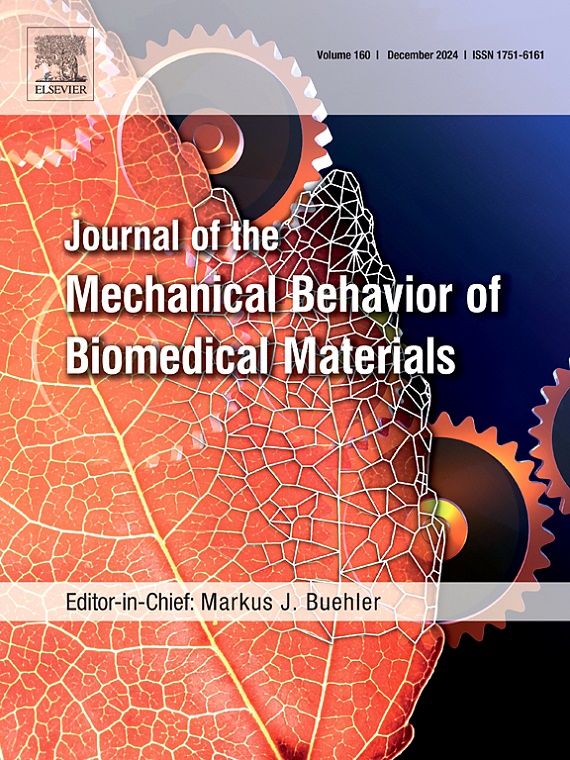A biomechanical analysis of cervical fixation methods using shaped meshes for pelvic floor reconstruction in a porcine model
IF 3.3
2区 医学
Q2 ENGINEERING, BIOMEDICAL
Journal of the Mechanical Behavior of Biomedical Materials
Pub Date : 2025-04-18
DOI:10.1016/j.jmbbm.2025.107026
引用次数: 0
Abstract
Purpose
Pelvic organ prolapse (POP) in women is a common condition. Polypropylene meshes have an important place in the treatment. To date, a biomechanical comparison with a specific mesh design has not been performed for cervical fixation. The purpose of this study was to evaluate the biomechanical properties of different polypropylene mesh shapes and their fastening.
Methods
Biomechanical testing was performed with a porcine model using the Tension Testing machine Instron 5565®. The cervix was fixated in the Instron 5565® to measure its biomechanical properties. Measurement parameters comprised the maximum load (N), displacement at failure (mm), and stiffness (N/mm). In total, sixty trials were performed. These trials were subdivided into three groups. The first group used Y-shaped meshes fixated with 4 sutures (Y4). The second group used a Y-shaped mesh with 6 sutures (Y6). The third group comprised the standard cervical fixation (SF) utilizing a rectangular mesh with three sutures fixed horizontally on the anterior of the cervix.
Results
Y6 displayed the highest maximum load of 114 ± 19.4 N with displacement at failure 53.2 ± 12.3 mm. SF yielded the highest stiffness value 2.7 ± 0.74 N/mm with the second lowest maximum load and lowest displacement at failure. Y4 displayed the lowest maximum load 73,3 ± 20.5 N, second highest displacement at failure 40.5 ± 9.2 mm, and lowest stiffness 1.99 ± 0.85 N/mm.
Conclusion
Y6 displayed the overall highest results for maximum load and displacement at failure. The data derived from this study show that factors such as the shape of the mesh, number of sutures, and location of sutures play an important role in the uniaxial biomechanical properties.
猪模型盆底重建用异形网格颈椎固定方法的生物力学分析
目的 妇女盆腔器官脱垂(POP)是一种常见病。聚丙烯网片在治疗中占有重要地位。迄今为止,还没有针对宫颈固定进行过特定网片设计的生物力学比较。本研究的目的是评估不同形状的聚丙烯网及其固定方式的生物力学特性。方法使用 Instron 5565® 拉伸试验机对猪模型进行生物力学测试。宫颈被固定在 Instron 5565® 中,以测量其生物力学特性。测量参数包括最大载荷(牛顿)、破坏时的位移(毫米)和刚度(牛顿/毫米)。总共进行了 60 次试验。这些试验被细分为三组。第一组使用 Y 形网片,用 4 根缝线固定(Y4)。第二组使用 Y 型网片,缝合 6 针(Y6)。第三组包括标准宫颈固定术(SF),采用矩形网片,在宫颈前方水平固定 3 根缝线。SF 的刚度值最高,为 2.7 ± 0.74 N/mm,最大载荷和破坏时位移均为第二低。Y4 的最大载荷为 73.3 ± 20.5 N,位移为 40.5 ± 9.2 mm,刚度为 1.99 ± 0.85 N/mm。本研究得出的数据表明,网片形状、缝合线数量和缝合线位置等因素对单轴生物力学特性起着重要作用。
本文章由计算机程序翻译,如有差异,请以英文原文为准。
求助全文
约1分钟内获得全文
求助全文
来源期刊

Journal of the Mechanical Behavior of Biomedical Materials
工程技术-材料科学:生物材料
CiteScore
7.20
自引率
7.70%
发文量
505
审稿时长
46 days
期刊介绍:
The Journal of the Mechanical Behavior of Biomedical Materials is concerned with the mechanical deformation, damage and failure under applied forces, of biological material (at the tissue, cellular and molecular levels) and of biomaterials, i.e. those materials which are designed to mimic or replace biological materials.
The primary focus of the journal is the synthesis of materials science, biology, and medical and dental science. Reports of fundamental scientific investigations are welcome, as are articles concerned with the practical application of materials in medical devices. Both experimental and theoretical work is of interest; theoretical papers will normally include comparison of predictions with experimental data, though we recognize that this may not always be appropriate. The journal also publishes technical notes concerned with emerging experimental or theoretical techniques, letters to the editor and, by invitation, review articles and papers describing existing techniques for the benefit of an interdisciplinary readership.
 求助内容:
求助内容: 应助结果提醒方式:
应助结果提醒方式:


